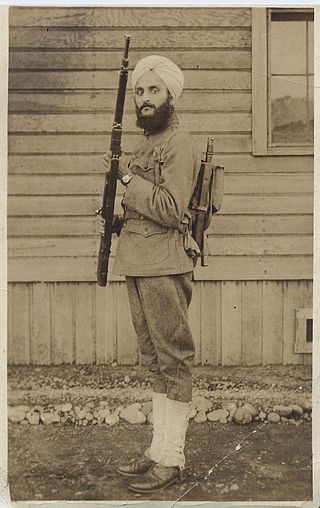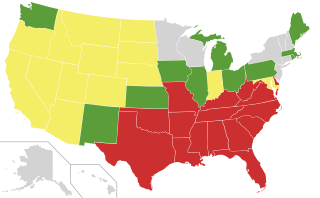
Racial segregation is the separation of people into racial or other ethnic groups in daily life. Segregation can involve the spatial separation of the races, and mandatory use of different institutions, such as schools and hospitals by people of different races. Specifically, it may be applied to activities such as eating in restaurants, drinking from water fountains, using public toilets, attending schools, going to films, riding buses, renting or purchasing homes or renting hotel rooms. In addition, segregation often allows close contact between members of different racial or ethnic groups in hierarchical situations, such as allowing a person of one race to work as a servant for a member of another race. Racial segregation has generally been outlawed worldwide.
Miscegenation is marriage or admixture between people who are members of different races. The word, now usually considered pejorative, is derived from a combination of the Latin terms miscere and genus. The word first appeared in Miscegenation: The Theory of the Blending of the Races, Applied to the American White Man and Negro, an anti-abolitionist pamphlet David Goodman Croly and others published anonymously in advance of the 1864 presidential election in the United States. The term came to be associated with laws that banned interracial marriage and sex, which were known as anti-miscegenation laws. These laws were overruled federally in 1967, and by the year 2000, all states had removed them from their laws, with Alabama being the last to do so on November 7, 2000. In the 21st century, newer scientific data shows that human populations are actually genetically quite similar. Studies show that races are more of an arbitrary social construct, and do not actually have a major genetic delineation.
Separate but equal was a legal doctrine in United States constitutional law, according to which racial segregation did not necessarily violate the Fourteenth Amendment to the United States Constitution, which nominally guaranteed "equal protection" under the law to all people. Under the doctrine, as long as the facilities provided to each race were equal, state and local governments could require that services, facilities, public accommodations, housing, medical care, education, employment, and transportation be segregated by race, which was already the case throughout the states of the former Confederacy. The phrase was derived from a Louisiana law of 1890, although the law actually used the phrase "equal but separate".
Loving v. Virginia, 388 U.S. 1 (1967), was a landmark civil rights decision of the U.S. Supreme Court which ruled that laws banning interracial marriage violate the Equal Protection and Due Process Clauses of the Fourteenth Amendment to the U.S. Constitution. Beginning in 2013, the decision was cited as precedent in U.S. federal court decisions ruling that restrictions on same-sex marriage in the United States were unconstitutional, including in the Supreme Court decision Obergefell v. Hodges (2015).
The one-drop rule was a legal principle of racial classification that was prominent in the 20th-century United States. It asserted that any person with even one ancestor of black ancestry is considered black. It is an example of hypodescent, the automatic assignment of children of a mixed union between different socioeconomic or ethnic groups to the group with the lower status, regardless of proportion of ancestry in different groups.
Lum v. Rice, 275 U.S. 78 (1927), is a United States Supreme Court case in which the Court held that the exclusion on account of race of a child of Chinese ancestry from a public school did not violate the Fourteenth Amendment to the United States Constitution. The decision effectively approved the exclusion of any minority children from schools reserved for whites.

In 1924, the Virginia General Assembly enacted the Racial Integrity Act. The act reinforced racial segregation by prohibiting interracial marriage and classifying as "white" a person "who has no trace whatsoever of any blood other than Caucasian". The act, an outgrowth of eugenicist and scientific racist propaganda, was pushed by Walter Plecker, a white supremacist and eugenicist who held the post of registrar of the Virginia Bureau of Vital Statistics.
Takao Ozawa v. United States, 260 U.S. 178 (1922), was a US legal proceeding. The United States Supreme Court found Takao Ozawa, a Japanese American who was born in Japan but had lived in the United States for 20 years, ineligible for naturalization. In 1914, Ozawa filed for United States citizenship under the Naturalization Act of 1906. This act allowed only "free white persons" and "persons of African nativity or persons of African descent" to naturalize. Ozawa did not challenge the constitutionality of the racial restrictions. Instead, he claimed that Japanese people should be properly classified as "free white persons".
Racism has been reflected in discriminatory laws, practices, and actions against "racial" or ethnic groups, throughout the history of the United States. Since the early colonial era, White Americans have generally enjoyed legally or socially sanctioned privileges and rights, which have been denied to members of various ethnic or minority groups at various times. European Americans have enjoyed advantages in matters of citizenship, criminal procedure, education, immigration, land acquisition, and voting rights.
United States v. Bhagat Singh Thind, 261 U.S. 204 (1923), was a case in which the Supreme Court of the United States decided that Bhagat Singh Thind, an Indian Sikh man who identified himself as an Aryan, was ineligible for naturalized citizenship in the United States. In 1919, Thind filed a petition for naturalization under the Naturalization Act of 1906 which allowed only "free white persons" and "aliens of African nativity and persons of African descent" to become United States citizens by naturalization.

Bhagat Singh Thind was an Indian American writer and lecturer on spirituality who served in the United States Army during World War I and was involved in a Supreme Court case over the right of Indian people to obtain United States citizenship. He was among a group of men of Indian ancestry who attempted to claim he was White and naturalize under federal naturalization law.
Asian immigration to the United States refers to immigration to the United States from part of the continent of Asia, which includes East Asia, South Asia, and Southeast Asia. Asian-origin populations have historically been in the territory that would eventually become the United States since the 16th century. The first major wave of Asian immigration occurred in the late 19th century, primarily in Hawaii and the West Coast. Asian Americans experienced exclusion, and limitations to immigration, by the United States law between 1875 and 1965, and were largely prohibited from naturalization until the 1940s. Since the elimination of Asian exclusion laws and the reform of the immigration system in the Immigration and Nationality Act of 1965, there has been a large increase in the number of immigrants to the United States from Asia.

The Naturalization Act of 1790 was a law of the United States Congress that set the first uniform rules for the granting of United States citizenship by naturalization. The law limited naturalization to "free white person(s) ... of good character", thus excluding Native Americans, indentured servants, enslaved people, free Africans, Pacific Islanders, and non-White Asians. This eliminated ambiguity on how to treat newcomers, given that free black people had been allowed citizenship at the state level in many states. In reading the Naturalization Act, the courts also associated whiteness with Christianity and thus excluded Muslim immigrants from citizenship until the decision Ex Parte Mohriez recognized citizenship for a Saudi Muslim man in 1944.
The racial classification of Indian Americans has varied over the years and across institutions. Originally, neither the courts nor the census bureau classified Indian Americans as a race because there were only negligible numbers of Indian immigrants in the United States. Early Indian Americans were often denied their civil rights, leading to close affiliations with African Americans. For most of America's early history, the government only recognized two racial classifications, white or colored. Due to immigration laws of the time, those deemed colored were often stripped of their American citizenship or denied the ability to become citizens. For these reasons, various South Asians in America took the government to court to try to be considered white instead of colored. After advocacy from the Indian American community, the racial category of Asian Indian was finally introduced in the 1980 U.S. census.
The legal and social strictures that define White Americans, and distinguish them from persons who are not considered white by the government and society, have varied throughout the history of the United States. Race is defined as a social and political category within society based on hierarchy.
During the 18th and most of the 19th centuries, the United States had limited regulation of immigration and naturalization at a national level. Under a mostly prevailing "open border" policy, immigration was generally welcomed, although citizenship was limited to “white persons” as of 1790, and naturalization subject to five year residency requirement as of 1802. Passports and visas were not required for entry into America, rules and procedures for arriving immigrants were determined by local ports of entry or state laws. Processes for naturalization were determined by local county courts.
In the United States, economic competition and racial prejudice have both contributed to long-lasting racial tensions between African Americans and Hispanic and Latino Americans. There have also been inter-racial tensions between African Americans and Asian Americans.

Interracial marriage has been legal throughout the United States since at least the 1967 U.S. Supreme Court decision Loving v. Virginia (1967) that held that anti-miscegenation laws were unconstitutional via the 14th Amendment adopted in 1868. Chief Justice Earl Warren wrote in the court opinion that "the freedom to marry, or not marry, a person of another race resides with the individual, and cannot be infringed by the State." Interracial marriages have been formally protected by federal statute through the Respect for Marriage Act since 2022.

In the United States, many U.S. states historically had anti-miscegenation laws which prohibited interracial marriage and, in some states, interracial sexual relations. Some of these laws predated the establishment of the United States, and some dated to the later 17th or early 18th century, a century or more after the complete racialization of slavery. Nine states never enacted anti-miscegenation laws, and 25 states had repealed their laws by 1967. In that year, the U.S. Supreme Court ruled in Loving v. Virginia that such laws are unconstitutional under the Fourteenth Amendment to the U.S. Constitution.







